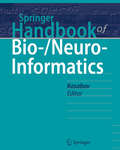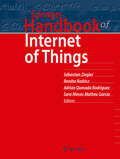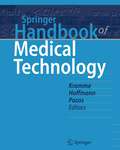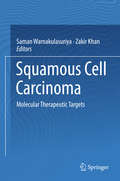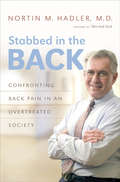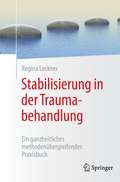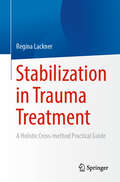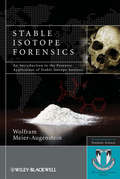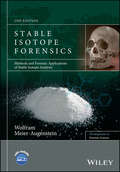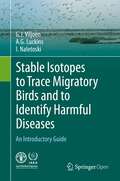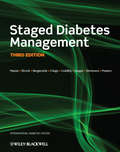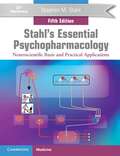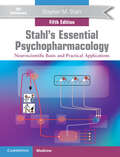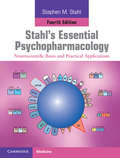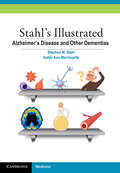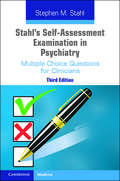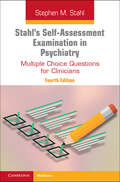- Table View
- List View
Springer Handbook of Aerogels (Springer Handbooks)
by Nicholas Leventis Michel A. Aegerter Matthias Koebel Stephen A. SteinerThis indispensable handbook provides comprehensive coverage of the current state-of-the-art in inorganic, organic, and composite aerogels – from synthesis and characterization to cutting-edge applications and their potential market impact. Built upon Springer’s successful Aerogels Handbook published in 2011, this handbook features extensive revisions and timely updates, reflecting the changes in this fast-growing field. Aerogels are the lightest solids known to man. Up to 1000 times lighter than glass and with a density only four times that of air, they possess extraordinarily high thermal, electrical, and acoustic insulation properties, and boast numerous entries in Guinness World Records. Originally based on silica, R&D efforts have extended this class of materials to incorporate non-silicate inorganic oxides, natural and synthetic organic polymers, carbon, metal, and ceramic materials. Composite systems involving polymer-crosslinked aerogels and interpenetrating hybrid networks have been developed and exhibit remarkable mechanical strength and flexibility. Even more exotic aerogels based on clays, chalcogenides, phosphides, quantum dots, and biopolymers such as chitosan are opening new applications for the construction, transportation, energy, defense and healthcare industries. Applications in electronics, chemistry, mechanics, engineering, energy production and storage, sensors, medicine, nanotechnology, military and aerospace, oil and gas recovery, thermal insulation, and household uses are being developed.Readers of this fully updated and expanded edition will find an exhaustive source for all aerogel materials known today, their fabrication, upscaling aspects, physical and chemical properties, and the most recent advances towards applications and commercial use. This key reference is essential reading for a combined audience of graduate students, academic researchers, and industry professionals.
Springer Handbook of Bio-/Neuroinformatics
by Nikola KasabovThe Springer Handbook of Bio-/Neuro-Informatics is the first published book in one volume that explains together the basics and the state-of-the-art of two major science disciplines in their interaction and mutual relationship, namely: information sciences, bioinformatics and neuroinformatics. Bioinformatics is the area of science which is concerned with the information processes in biology and the development and applications of methods, tools and systems for storing and processing of biological information thus facilitating new knowledge discovery. Neuroinformatics is the area of science which is concerned with the information processes in biology and the development and applications of methods, tools and systems for storing and processing of biological information thus facilitating new knowledge discovery. The text contains 62 chapters organized in 12 parts, 6 of them covering topics from information science and bioinformatics, and 6 cover topics from information science and neuroinformatics. Each chapter consists of three main sections: introduction to the subject area, presentation of methods and advanced and future developments. The Springer Handbook of Bio-/Neuroinformatics can be used as both a textbook and as a reference for postgraduate study and advanced research in these areas. The target audience includes students, scientists, and practitioners from the areas of information, biological and neurosciences. With Forewords by Shun-ichi Amari of the Brain Science Institute, RIKEN, Saitama and Karlheinz Meier of the University of Heidelberg, Kirchhoff-Institute of Physics and Co-Director of the Human Brain Project.
Springer Handbook of Internet of Things (Springer Handbooks)
by Sébastien Ziegler Adrian Quesada Rodriguez Renáta Radócz Sara Nieves Matheu GarciaThis handbook is an authoritative, comprehensive reference on Internet of Things, written for practitioners, researchers, and students around the world. This book provides a definitive single point of reference material for all those interested to find out information about the basic technologies and approaches that are used to design and deploy IoT applications across a vast variety of different application fields spanning from smart buildings, smart cities, smart factories, smart farming, building automation, connected vehicles, and machine to machine communication. The book is divided into ten parts, each edited by top experts in the field. The parts include: IoT Basics, IoT Hardware and Components, Architecture and Reference Models, IoT Networks, Standards Overview, IoT Security and Privacy, From Data to Knowledge and Intelligence, Application Domains, Testbeds and Deployment, and End-User Engagement. The contributors are leading authorities in the fields of engineering and represent academia, industry, and international government and regulatory agencies.
Springer Handbook of Medical Technology
by Robert Steven Pozos Klaus-Peter Hoffmann Rüdiger KrammeThis concise, user-oriented and up-to-date desk reference offers a broad introduction to the fascinating world of medical technology, fully considering today's progress and further development in all relevant fields. The Springer Handbook of Medical Technology is a systemized and well-structured guideline which distinguishes itself through simplification and condensation of complex facts. This book is an indispensable resource for professionals working directly or indirectly with medical systems and appliances every day. It is also meant for graduate and post graduate students in hospital management, medical engineering, and medical physics.
Springer Lexikon Kosmetik und Körperpflege
by Marina Bährle-RappDas Nachschlagewerk bietet ausführliche Informationen rund um die Themen Haut, Haare, Nägel, Nagelmodellage, Beauty-Medizin und Gerätekunde. Die Autorin listet kosmetische Inhaltsstoffe mit ihrer gültigen INCI-Bezeichnung auf, beschreibt und bewertet diese und gibt darüber hinaus Schmink- und Pflegetipps. Der Band liefert verständliche Erläuterungen zu insgesamt 11.500 Stichworten, die wichtigsten englischen und französischen Fachtermini sind übersetzt. Die Autorin wurde 2006 für ihr profundes Wissen mit dem Christine-Schrammek-Preis ausgezeichnet.
Spurgeon's Color Atlas of Large Animal Anatomy: The Essentials
by Thomas L. Spurgeon Thomas O. Mccracken Robert A. KainerExtraordinary accuracy and beautiful original artwork are just two features readers will find in this new resource, providing a basic foundation in domestic large animal anatomy.<P><P> Its unique organization includes the anatomy of all organ systems in the various species, described in a consistent manner. The book presents relevant anatomy of the following species: Horse (with contributors by Dr. Gayle Trotter) Ox (with contributions by Dr. Fran Garry) Sheep and goat (with contributions by Dr. Joan Bowen) Llama and alpaca (with contributions by Dr. LaRue Johnson) Swine (with contributions by Dr. LaRue Johnson) and chicken (with contributions by Dr. John Avens). Features that enhance understanding: Carefully selected labeling helps students learn and remember structures and relationships. Male and female of a given species are depicted on facing pages so that topographic anatomy is easy to compare. Structures common to various animals are labeled several times, whereas unique structrur5es are labeled only on one or two species so students can make rapid distinctions of the structures peculiar to certain animals. An introduction provides readers with a background in nomenclature and anatomic orientation so they can benefit from the atlas even if they lack training in anatomy. The Atlas depicts topographic relationships of major organs in a simple, yet technically accurate presentation that's free of extraneous detail so that those using the atlas can concentrate on the essential aspects of anatomy.
Squamous cell Carcinoma
by Saman Warnakulasuriya Zakir KhanThis edited volume is about novel targeted therapies for the treatment of advanced neoplasms of the head and neck (HNSCC) with particular reference to oral squamous cell carcinomas and covers specific fields of cancer genetics and genomics for personalized medicine. The landmark studies from the HNSCC Cancer Genome Anatomy (TCGA) and the cancer Genome Atlas 2015 have revealed the multiplicity and diversity of genetic alterations in HNSCC. This remarkable body of information has elucidated novel druggable targets (eg. EGFR, mTOR, p53, survivin and aberrant microRNA) for therapeutic interventions in head and neck cancer. Readers will discover the importance of the biology and pathology of squamous cell carcinomas, the role of cancer stem cells and other factors that contribute to resistance to curative therapies such as hypoxia. We present an in-depth analysis of the HNSCC oncogenome describing the distinct molecular alterations in squamous cell carcinomas, which participate in specific molecular pathways whose dysregulation may contribute to most HNSCC cases. Final chapters of the book elucidate how these important cancer-driving molecular events and molecular pathways could be targeted to treat head and neck cancers and their therapeutic applications for targeted therapies based on clinical trials reported worldwide. This book is aimed at a broad audience, including scientists, physicians, surgeons, and post graduate students engaged in oncology and provide the readers with an up-to-date, interdisciplinary knowledge and tools to better understand the evolving areas of targeted gene therapy and the key concept of personalized medicine in head and neck cancer.
Stabbed in the Back
by Nortin M. HadlerNortin Hadler knows backaches. For more than three decades as a physician and medical researcher, he has studied the experience of low back pain in people who are otherwise healthy. Hadler terms the low back pain that everyone suffers at one time or another "regional back pain. " In this book, he addresses the history and treatment of the ailment with the healthy skepticism that has become his trademark, taking the "Hadlerian" approach to backaches and the backache treatment industry in order to separate the helpful from the hype. Basing his critique on an analysis of the most current medical literature as well as his clinical experience, Hadler argues that regional back pain is overly medicalized by doctors, surgeons, and alternative therapists who purvey various treatment regimens. Furthermore, he observes, the design of workers' compensation, disability insurance, and other "health" schemes actually thwarts getting well. For the past half century, says Hadler, back pain and back pain-related disability have exacted a huge toll, in terms of pain, suffering, and financial cost. Stabbed in the Backaddresses this issue at multiple levels: as a human predicament, a profound social problem, a medical question, and a vexing public-policy challenge. Ultimately, Hadler's insights illustrate how the state of the science can and should inform the art and practice of medicine as well as public policy. Stabbed in the Backwill arm any reader with the insights necessary to make informed decisions when confronting the next episode of low back pain.
Stabilisierung in der Traumabehandlung: Ein ganzheitliches methodenübergreifendes Praxisbuch
by Regina LacknerStabilisierung gilt als die erste der drei Phasen der Traumabehandlung und als Voraussetzung für eine gelingende Traumakonfrontation. Was bedeutet aber Stabilisierung, welche Wirkung hat sie und vor allem: welche Vielfalt an stabilisierenden Interventionen gibt es?Das Praxisbuch stellt verschiedene Zugänge und eine Fülle an unterschiedlichen in der Praxis bewährten Interventionen und Übungen vor. Darüber hinaus zeigt es anschaulich, dass Stabilisierung weitaus mehr bewirken kann, als man vermuten mag: sie bringt eine Vielfalt an weiteren Wirkungen mit sich, sodass sie zu einer umfassenden Stärkung und Heilung unserer Klienten beiträgt. Damit erleichtert, beschleunigt und erweitert sie den Prozess der Traumabehandlung. Ein großes Repertoire an Interventionen, Übungen und Anregungen sowie zahlreiche Beispiele veranschaulichen die Umsetzung in der Praxis. Das Buch richtet sich an Psychotherapeut*innen, Psycholog*innen, Ärzt*innen und Angehörige anderer helfender Berufe.
Stabilization in Trauma Treatment: A Holistic Cross-method Practical Guide
by Regina LacknerStabilization is considered the first of the three phases of trauma treatment and a prerequisite for successful trauma confrontation. But what does stabilization mean, what effect does it have, and above all: what variety of stabilizing interventions are there?This practical guide presents various approaches and a wealth of different interventions and exercises that have proven themselves in practice. In addition, it clearly shows that stabilization can achieve much more than one might expect: it brings with it a variety of other effects, so that it contributes to a comprehensive strengthening and healing of our clients. Thus, it facilitates, accelerates and expands the process of trauma treatment. A large repertoire of interventions, exercises and suggestions, as well as numerous examples, illustrate its implementation in practice. The book is aimed at psychotherapists, psychologists, physicians and members of other helping professions.
Stable Isotope Forensics
by Wolfram Meier-AugensteinThis book provides the first comprehensive, overview and guide to forensic isotope analysis, an exciting new application of stable isotope analytical techniques. Topics are introduced using examples and real-life case studies such as food quality control where isotope analysis has already had a major impact, in terms of consumer protection, These examples illustrate the underlying principles of isotope profiling or fingerprinting. A section comprising actual criminal case work is used to build a bridge between the introduction and the technical section to encourage students to engage with this novel departure for analytical sciences while at the same time providing hands-on examples for the experienced researcher and forensic practitioner to match problems and success stories encountered with the topics discussed in the technical section.What little information is available on the subject in book form so far, has been published as individual chapters in books dealing either with mass spectrometry, forensic geoscience or environmental forensics, this is the first book to focus on the entire spectrum of forensic isotope analysis and will be an invaluable reference to both researchers in the field and forensic practitioners.
Stable Isotope Forensics: Methods and Forensic Applications of Stable Isotope Analysis
by Wolfram Meier-AugensteinThe number-one guide, internationally, to all aspects of forensic isotope analysis, thoroughly updated and revised and featuring many new case studies This edition of the internationally acclaimed guide to forensic stable isotope analysis uses real-world examples to bridge discussions of the basic science, instrumentation and analytical techniques underlying forensic isotope profiling and its various technical applications. Case studies describe an array of applications, many of which were developed by the author himself. They include cases in which isotope profiling was used in murder, and drugs-related crime investigations, as well as for pharmaceutical and food authenticity control studies. Updated with coverage of exciting advances occurring in the field since the publication of the 1st edition, this 2nd edition explores innovative new techniques and applications in forensic isotope profiling, as well as key findings from original research. More than a simple update, though, this edition has been significantly revised in order to address serious problems that can arise from non-comparable and unfit-for-purpose stable isotope data. To that end, Part II has been virtually rewritten with greater emphasis now being placed on important quality control issues in stable isotope analysis in general and forensic stable isotope analysis in particular. Written in a highly accessible style that will appeal to practitioners, researchers and students alike Illustrates the many strengths and potential pitfalls of forensic stable isotope analysis Uses recent case examples to bridge underlying principles with technical applications Presents hands-on applications that let experienced researchers and forensic practitioners match problems with success stories Includes new chapters devoted to aspects of quality control and quality assurance, including scale normalisation, the identical treatment principle, hydrogen exchange and accreditation Stable Isotope Forensics, 2nd Edition is an important professional resource for forensic scientists, law enforcement officials, public prosecutors, defence attorneys, forensic anthropologists and others for whom isotope profiling has become an indispensable tool of the trade. It is also an excellent introduction to the field for senior undergraduate and graduate forensic science students. "All students of forensic criminology, and all law enforcement officers responsible for the investigation of serious crime , will want to study this book. Wolfram highlights the value, and future potential, of Stable Isotope Forensics as an emerging powerful tool in the investigation of crime." —Roy McComb, Deputy Director, Specialist Investigations, National Crime Agency (NCA), UK “A single author text in these days is rare and the value of this book lies in the dedication and experience of the author which is evident in the clarity of prose, the honest illustration of evidence and the realistic practical application of the subject - it makes this a text of genuine scientific value.” — Prof Dame Sue Black, PhD, DBE, OBE, FRSE, Leverhulme Research Centre for Forensic Science, University of Dundee, UK
Stable Isotopes to Trace Migratory Birds and to Identify Harmful Diseases
by G. J. Viljoen A. G. Luckins I. NaletoskiThis manuscript discusses the potentials of the approaches as mentioned below to monitor the AIVs in WMW. Molecular diagnostic platforms enable for accurate detection of the AIVs in the feces of infected birds. Similar technologies can be used to determine the bird species through DNA barcoding, enabling non-invasive research on the epidemiology of the disease. Wild migratory waterfowl (WMW) play significant role in the transmission of avian influenza viruses (AIVs) on large distances. Understanding bird migrations may therefore significantly contribute towards understanding of the disease epidemiology, however most conventional approaches to trace WMW migrations are based on capturing, tagging (mostly ringing or GPS devices) and their re-capturing to link the departure and arrival places. Stable isotope ratios in metabolically inert tissues (feathers, beaks, claws) reflect the ratios present at the point of intake (drinking or feeding), thus enabling for tracing bird origins at stopover places. Molecular diagnostic platforms such as the polymerase chain reaction (PCR) enable for accurate detection of the AIVs in the feces of infected birds. Similar technologies (genetic sequencing) can be used to determine the bird species through DNA barcoding. Simple and easy collection of feather and fecal samples at the stopover places may generate a full information package on which species of WMW carries the AIVs (PCR+DNA barcoding on the feces), as well as the origin of these species (SI+DNA barcoding on the feathers). Therefore, such approaches enable for research on the epidemiology and the ecology of the AIVs in WMW using a non-invasive platform, which does not require capturing of WMW. This manuscript discusses the potentials of these approaches to monitor the AIVs in WMW. p>
Staged Diabetes Management
by Amy Criego Richard M. Bergenstal Oded Langer Robert Cuddihy Roger Mazze Margaret A. Powers Ellie S. Strock Gregg SimonsonThis new edition of the successful Staged Diabetes Management will again address the prominent issues of primary care diabetes management based on the International Diabetes Center's "Staged Diabetes Management" program, which it advocates as part of its mission statement. This systematic treatment program consists of practical solutions to the detection and treatment of diabetes, its complications, and such areas as metabolic syndrome, pre-diabete,s and diabetes in children using evidence-based medicine. The text reviews the fundamental basis of diabetes management and then addresses treatment of each type of diabetes and the major micro- and macrovascular complications.
Stahl's Essential Psychopharmacology
by Stephen M. Stahl Meghan M. Grady Nancy Muntner Stephen M. Stahl Meghan M. GradyDesigned with the distinctive, user-friendly presentation Dr Stahl's audience know and love, this new stream of Stahl books capitalize on Dr Stahl's greatest strength - the ability to address complex issues in an understandable way and with direct relevance to the everyday experience of clinicians. The book describes a wide-ranging and representative selection of clinical scenarios, making use of icons, questions/answers and tips. It follows these cases through the complete clinical encounter, from start to resolution, acknowledging all the complications, issues, decisions, twists and turns along the way. The book is about living through the treatments that work, the treatments that fail, and the mistakes made along the journey. This is psychiatry in real life - these are the patients from your waiting room - this book will reassure, inform and guide better clinical decision making.
Stahl's Essential Psychopharmacology
by Stephen M. Stahl Meghan M. Grady Nancy Muntner Stephen M. Stahl Meghan M. GradyDesigned with the distinctive, user-friendly presentation Dr Stahl's audience know and love, this new stream of Stahl books capitalize on Dr Stahl's greatest strength - the ability to address complex issues in an understandable way and with direct relevance to the everyday experience of clinicians. The book describes a wide-ranging and representative selection of clinical scenarios, making use of icons, questions/answers and tips. It follows these cases through the complete clinical encounter, from start to resolution, acknowledging all the complications, issues, decisions, twists and turns along the way. The book is about living through the treatments that work, the treatments that fail, and the mistakes made along the journey. This is psychiatry in real life - these are the patients from your waiting room - this book will reassure, inform and guide better clinical decision making.
Stahl's Essential Psychopharmacology: Neuroscientific Basis and Practical Applications
by Stephen M. StahlLong established as the preeminent source in its field, the eagerly anticipated fifth edition of Dr Stahl's essential textbook of psychopharmacology is here! With its use of icons and figures that form Dr Stahl's unique "visual language," the book is the single most readable source of information on disease and drug mechanisms for all students and mental health professionals seeking to understand and utilize current therapeutics, and to anticipate the future for novel medications. Every aspect of the book has been updated, with the clarity of explanation that only Dr Stahl can bring. <p><p>The new edition includes over 500 new or refreshed figures, an intuitive color scheme, fourteen new uses for older drugs and eighteen brand new drugs, coverage of Parkinson's Disease Psychosis, behavioral symptoms of dementia, and mixed features in major depressive episodes, and expanded information on the medical uses of cannabis and hallucinogen assisted psychotherapy.
Stahl's Essential Psychopharmacology: Neuroscientific Basis and Practical Applications
by Stephen M. StahlLong established as the preeminent source in its field, the eagerly anticipated fifth edition of Dr Stahl's essential textbook of psychopharmacology is here! With its use of icons and figures that form Dr Stahl's unique 'visual language', the book is the single most readable source of information on disease and drug mechanisms for all students and mental health professionals seeking to understand and utilize current therapeutics, and to anticipate the future for novel medications. Every aspect of the book has been updated, with the clarity of explanation that only Dr Stahl can bring. The new edition includes over 500 new or refreshed figures, an intuitive color scheme, fourteen new uses for older drugs and eighteen brand new drugs, coverage of Parkinson's Disease Psychosis, behavioural symptoms of dementia, and mixed features in major depressive episodes, and expanded information on the medical uses of cannabis and hallucinogen assisted psychotherapy.
Stahl's Essential Psychopharmacology: Neuroscientific Basis and Practical Applications (4th Edition) (Stahl's Essential Psychopharmacology Handbooks Ser.)
by Stephen M. Stahl Nancy MuntnerWith this fully revised fourth edition, Dr Stahl returns to the essential roots of what it means to become a neurobiologically empowered psychopharmacologist, expertly guided in the selection and combination of treatments for individual patients in practice. Embracing the unifying themes of 'symptom endophenotypes', dimensions of psychopathology that cut across syndromes, and 'symptoms and circuits', every aspect of the text has been updated to the frontiers of current knowledge, with the clarity of explanation and illustration that only Dr Stahl can bring. Integrating much of the basic neuroscience into the clinical chapters, and with major additions in the areas of psychosis, antipsychotics, antidepressants, impulsivity, compulsivity and addiction, this is the single most readily readable source of information on disease and drug mechanisms. This remains the essential text for all students and professionals in mental health seeking to understand and utilize current therapeutics, and to anticipate the future for novel medications.
Stahl's Illustrated Alzheimer's Disease and Other Dementias (Stahl's Illustrated)
by Stephen Stahl Debbi Morrissette Meghan GradyThe term “dementia” describes a collection of symptoms including cognitive dysfunction, memory loss, language and communication issues, and behavioural symptoms. There are numerous causes of dementia and, worldwide, over 35 million individuals have some form of dementia. This book describes the most common causes of dementia, reviews best practices for differentially diagnosing dementia, as well as management strategies to help improve quality of life for both patients and carers. Stahl's Illustrated Alzheimer's Disease and Other Dementias is a concise guide, with all concepts illustrated by full-color figures and tables, that will be familiar to readers of Stahl's Essential Psychopharmacology and The Prescriber's Guide. The visual learner will find that this book makes psychopharmacological concepts easier to master, and the non-visual learner will enjoy this book's short explanations of complex psychopharmacological concepts. Each chapter builds upon previous ones, synthesizing information about basic biology, diagnostics, treatment plans, complications, and comorbidities.
Stahl's Illustrated: Violence
by Stephen M. Stahl Nancy Muntner Stephen M. Stahl Debbi Ann Morrissette Debbi Ann MorrissetteStahl's Illustrated Violence is a concise and highly illustrated guide to the underlying neurobiology, genetic predisposition and management of aggressive behaviours in patients with psychiatric disorders. All of the titles in the Stahl's Illustrated series are designed to be fun. Concepts are illustrated by full-color images that will be familiar to readers of Stahl's Essential Psychopharmacology, 4th edition, and The Prescriber's Guide. The visual learner will find that these books make psychopharmacology concepts easy to master, while the non-visual learner will enjoy a shortened text version of complex psychopharmacology concepts. Each chapter builds on previous ones, synthesizing information from basic biology and diagnostics to building treatment plans and dealing with complications and comorbidities. Novices may want to begin by looking through all the graphics and gaining a feel for the visual vocabulary. Readers more familiar with these topics should find that going back and forth between images and text provides an interaction with which to vividly conceptualize complex pharmacologies. Each book ends with a Suggested Reading section to help guide more in-depth learning about particular concepts.
Stahl's Self-Assessment Examination in Psychiatry
by Stephen M. Stahl Meghan M. Grady Stephen M. Stahl Meghan M. Grady Debbi A. MorrissetteDr Stahl's books occupy a central position as core educational resources in the psychopharmacology literature. Building on Dr Stahl's exceptional ability to communicate complex principles and make them easily understandable, this book offers 150 self-assessment questions derived from the Neuroscience Education Institute's Master Psychopharmacology Program. The self-assessment questions will help the reader to identify areas of competence or the need for further study and offers CME credit. In addition, the questions themselves are learning exercises: each question is followed by a thorough explanation of the correct and incorrect answer choices. Readers can work through the questions to prepare for formal tests, including American Board of Psychiatry and Neurology examinations and to achieve MoC credits towards ongoing ABPN re-accreditation. The questions are also ideal training tools for those working in related clinical fields and in industry.
Stahl's Self-Assessment Examination in Psychiatry: Multiple Choice Questions for Clinicians
by Stephen M. StahlAs an excellent source of learning for prescribers specializing in psychiatry, primary care physicians, nurse practitioners, psychologists, and pharmacists, this new edition features approximately 150 questions, divided into ten core areas of psychiatry, helping you to identify areas in which you need further study. The majority of questions are new or updated in their explanations and referencing. Each question is followed by an explanation of the answer and a list of references. After completing the questions you will be better able to: diagnose patients presenting with psychiatric symptoms using accepted diagnostic standards and practices; implement evidence-based psychiatric treatment strategies aligned with the patient's recovery goals; integrate recent advances in diagnostic and treatment strategies into clinical practice according to best practice guidelines. This collection has been approved by the American Board of Psychiatry and Neurology as part of a lifelong learning and self-assessment program and as a component of maintenance of certification.
Stahl's Self-Assessment Examination in Psychiatry: Multiple Choice Questions for Clinicians
by Stephen StahlAs an excellent source of learning for prescribers specializing in psychiatry, primary care physicians, nurse practitioners, psychologists, and pharmacists, this new edition features approximately 150 questions, divided into ten core areas of psychiatry, helping to identify areas in which you need further study. The majority of questions are new or updated in their explanations and referencing. Each question is followed by an explanation of the answer and a list of references. After completing the questions you will be better able to: diagnose patients presenting with psychiatric symptoms using accepted diagnostic standards and practices; implement evidence-based psychiatric treatment strategies aligned with the patient's recovery goals; integrate recent advances in diagnostic and treatment strategies into clinical practice according to best practice guidelines. This collection has been approved by the American Board of Psychiatry and Neurology as part of a lifelong learning and self-assessment program and as a component of maintenance of certification.
Stahl’s Self-Assessment Examination in Psychiatry
by Stephen M. Stahl Meghan M. Grady Stahl, Stephen M. and Grady, Meghan M.This book is for prescribers specializing in psychiatry, primary care physicians, nurse practitioners, psychologists and pharmacists. Featuring one hundred and fifty new and updated case-based questions, divided into ten core areas of psychiatry, this collection will help you identify areas in which you need further study. Each question is followed by an explanation of the answer and a list of references. After completing the questions you will be better able to: • diagnose patients presenting with psychiatric symptoms using accepted diagnostic standards and practices • implement evidence-based psychiatric treatment strategies aligned with the patient's recovery goals • integrate recent advances in diagnostic and treatment strategies into clinical practice according to best practice guidelines. This collection has been approved by the American Board of Psychiatry and Neurology as part of a lifelong learning and self-assessment program and as a component of maintenance of certification. Optional posttests with CME credit are available for a fee (waived for NEI members). For more information, contact the Neuroscience Education Institute.

